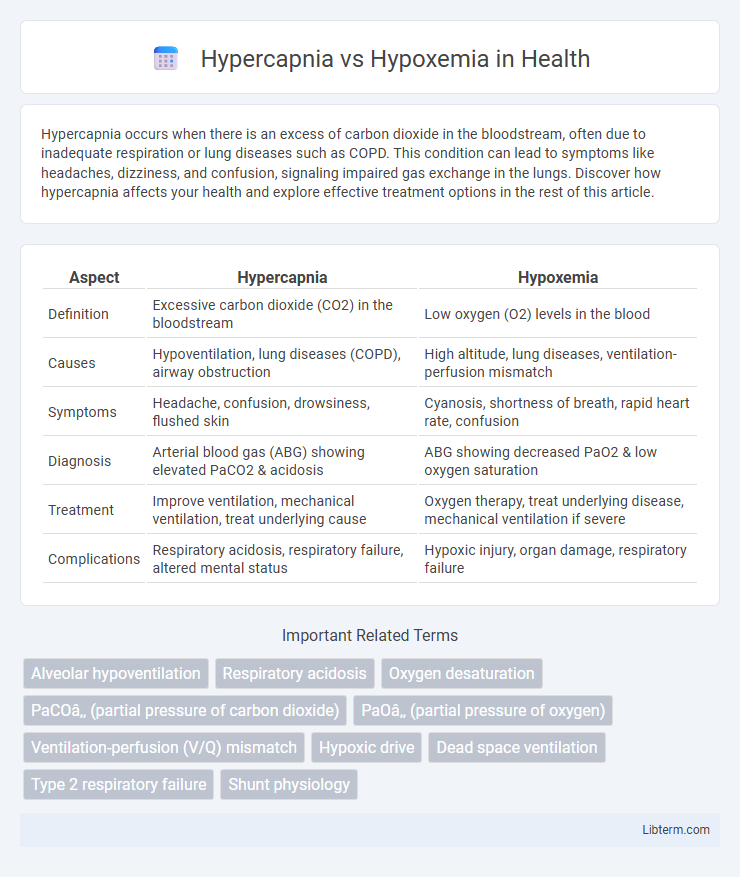Hypercapnia occurs when there is an excess of carbon dioxide in the bloodstream, often due to inadequate respiration or lung diseases such as COPD. This condition can lead to symptoms like headaches, dizziness, and confusion, signaling impaired gas exchange in the lungs. Discover how hypercapnia affects your health and explore effective treatment options in the rest of this article.
Table of Comparison
| Aspect | Hypercapnia | Hypoxemia |
|---|---|---|
| Definition | Excessive carbon dioxide (CO2) in the bloodstream | Low oxygen (O2) levels in the blood |
| Causes | Hypoventilation, lung diseases (COPD), airway obstruction | High altitude, lung diseases, ventilation-perfusion mismatch |
| Symptoms | Headache, confusion, drowsiness, flushed skin | Cyanosis, shortness of breath, rapid heart rate, confusion |
| Diagnosis | Arterial blood gas (ABG) showing elevated PaCO2 & acidosis | ABG showing decreased PaO2 & low oxygen saturation |
| Treatment | Improve ventilation, mechanical ventilation, treat underlying cause | Oxygen therapy, treat underlying disease, mechanical ventilation if severe |
| Complications | Respiratory acidosis, respiratory failure, altered mental status | Hypoxic injury, organ damage, respiratory failure |
Introduction to Hypercapnia and Hypoxemia
Hypercapnia refers to elevated levels of carbon dioxide (CO2) in the blood, typically caused by hypoventilation or impaired gas exchange in respiratory conditions such as chronic obstructive pulmonary disease (COPD). Hypoxemia denotes low oxygen levels in arterial blood, resulting from factors like ventilation-perfusion mismatch, diffusion defects, or shunting. Both conditions impact respiratory function and oxygen delivery but differ fundamentally in their primary gas imbalances: increased CO2 in hypercapnia versus decreased oxygen in hypoxemia.
Defining Hypercapnia: Causes and Mechanisms
Hypercapnia, characterized by elevated carbon dioxide (CO2) levels in the blood, occurs due to hypoventilation, impaired gas exchange, or increased CO2 production. Common causes include chronic obstructive pulmonary disease (COPD), respiratory muscle fatigue, and central nervous system depression affecting respiratory drive. The underlying mechanism involves inadequate removal of CO2 by the lungs, leading to respiratory acidosis and altered oxygen delivery.
Understanding Hypoxemia: Causes and Mechanisms
Hypoxemia refers to low arterial oxygen levels primarily caused by ventilation-perfusion mismatch, diffusion impairment, or hypoventilation. Common mechanisms include chronic obstructive pulmonary disease (COPD), pulmonary fibrosis, and high altitude exposure, leading to insufficient oxygen diffusion into the bloodstream. Understanding these underlying causes is crucial for effective diagnosis and targeted treatment strategies in respiratory medicine.
Key Differences Between Hypercapnia and Hypoxemia
Hypercapnia refers to elevated levels of carbon dioxide (CO2) in the blood, whereas hypoxemia is characterized by low oxygen (O2) levels in arterial blood. Hypercapnia primarily results from impaired ventilation or respiratory failure, leading to CO2 retention, while hypoxemia arises due to inadequate oxygen exchange caused by conditions like lung diseases or circulation problems. Clinically, hypercapnia presents with symptoms such as headache and confusion, whereas hypoxemia manifests through cyanosis, shortness of breath, and potential organ dysfunction due to oxygen deprivation.
Clinical Signs and Symptoms Comparison
Hypercapnia presents with symptoms such as headache, confusion, flushed skin, and rapid breathing, reflecting elevated carbon dioxide levels in the blood. Hypoxemia primarily manifests through cyanosis, shortness of breath, tachycardia, and restlessness due to inadequate oxygenation. Both conditions can cause altered mental status, but hypercapnia often leads to drowsiness, whereas hypoxemia typically results in anxiety and agitation.
Diagnostic Approaches for Hypercapnia vs Hypoxemia
Diagnostic approaches for hypercapnia primarily involve arterial blood gas (ABG) analysis to measure elevated partial pressure of carbon dioxide (PaCO2), while hypoxemia diagnosis focuses on assessing low partial pressure of oxygen (PaO2) through pulse oximetry and ABG tests. Capnography serves as a non-invasive tool to monitor CO2 levels in patients suspected of hypercapnia, complementing ABG results. Imaging studies and pulmonary function tests aid in identifying underlying causes contributing to both hypercapnia and hypoxemia, guiding targeted management strategies.
Underlying Medical Conditions and Risk Factors
Hypercapnia commonly results from chronic obstructive pulmonary disease (COPD), neuromuscular disorders, or chest wall deformities that impair ventilation, leading to elevated carbon dioxide levels in the blood. Hypoxemia is frequently associated with conditions such as pneumonia, pulmonary embolism, and interstitial lung disease, which disrupt oxygen exchange at the alveolar level. Risk factors for hypercapnia include obesity hypoventilation syndrome and sedative drug use, while hypoxemia risk factors encompass high altitude exposure, cardiac shunts, and severe anemia.
Treatment Strategies: Hypercapnia vs Hypoxemia
Treatment strategies for hypercapnia focus on improving ventilation through methods such as non-invasive positive pressure ventilation (NIPPV), mechanical ventilation, and addressing underlying causes like chronic obstructive pulmonary disease (COPD) exacerbations. Hypoxemia management prioritizes oxygen therapy via nasal cannula, face masks, or high-flow devices to increase arterial oxygen saturation, along with treating conditions like pneumonia or pulmonary embolism. Both conditions require careful monitoring of blood gases through arterial blood gas analysis to tailor interventions and prevent complications.
Potential Complications and Prognosis
Hypercapnia, characterized by elevated carbon dioxide levels in the blood, can lead to respiratory acidosis, altered mental status, and in severe cases, respiratory failure and arrhythmias. Hypoxemia, defined by low arterial oxygen tension, poses risks such as tissue hypoxia, organ dysfunction, and in chronic states, pulmonary hypertension and right heart failure. The prognosis of hypercapnia often depends on underlying lung function and the ability to manage ventilation, while hypoxemia prognosis hinges on the severity of oxygen deprivation and timeliness of oxygen therapy.
Prevention and Patient Management Tips
Preventing hypercapnia involves ensuring adequate ventilation through techniques like non-invasive positive pressure ventilation and monitoring carbon dioxide levels in patients with chronic respiratory conditions. Hypoxemia management prioritizes supplemental oxygen therapy, regular pulse oximetry assessments, and addressing underlying causes such as pulmonary infections or chronic obstructive pulmonary disease. Patient education on adherence to prescribed treatments and lifestyle modifications, including smoking cessation and pulmonary rehabilitation, plays a crucial role in minimizing complications related to both hypercapnia and hypoxemia.
Hypercapnia Infographic

 libterm.com
libterm.com